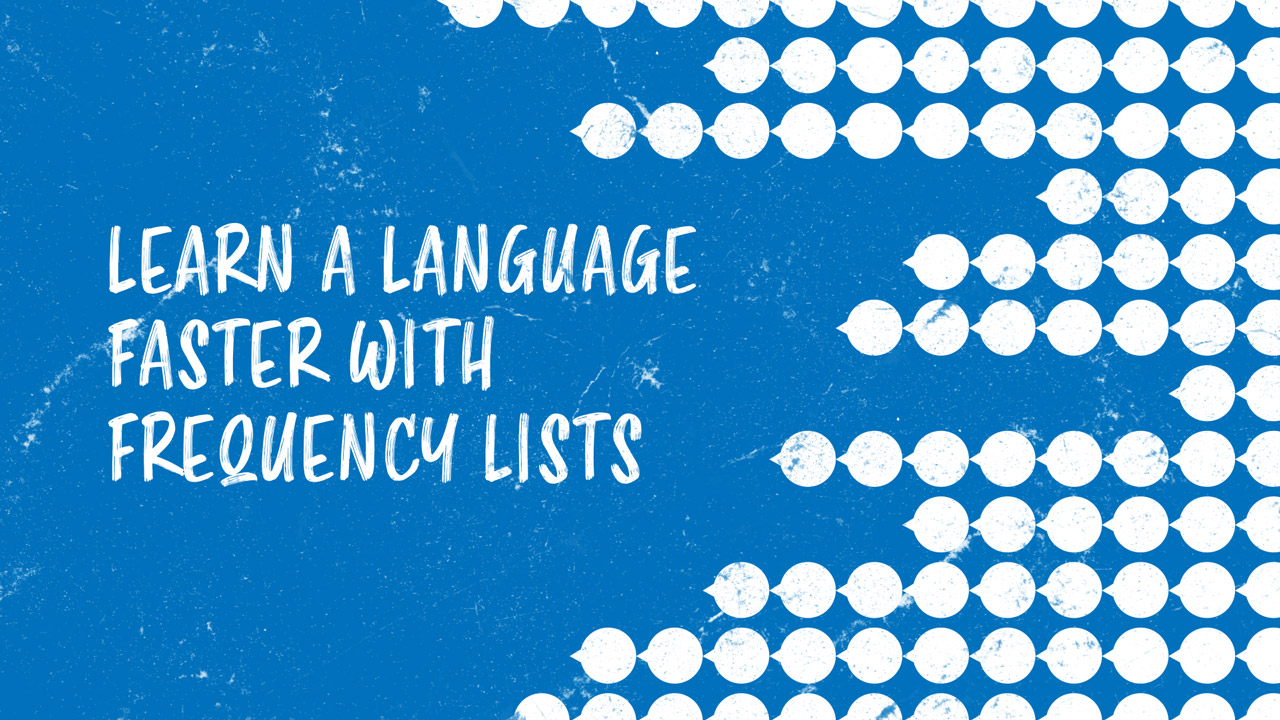How to Learn a Language in Record Time With Frequency Lists
Do you find yourself wondering where to start learning a new language? What are the basics you need to start with? What are the right words to learn? We’ve got the answers right here.
Learning a language, especially from scratch, can be a slow and tedious process. Sometimes, learners find it hard to have a conversation in their target language even if they put in the effort and keep learning new words constantly.
The problem lies within their choice of words to learn.

Languages are made up of a large number of words. The English language, for instance, comprises over a million total words! However, learning all the words in a language is not necessary to be proficient in a language.
Now you might be wondering which words out of these should be learned?
This is why you need frequency lists.
What are Frequency Lists?
Frequency lists are lists of words in a language grouped according to their frequency of occurrence within a given text corpus. A text corpus is a large and structured collection of authentic texts used as a language resource. Your text corpus will be the general literature from a language of your interest.
To put it simply, frequency lists are a collection of words most frequently used in a language. These lists can help you identify which words are most important in a language depending on their usage, and how often they appear during speech.
Frequency lists are very important for language learning. They provide you with a list of words you will find in abundance while trying to learn so that you can familiarize yourself with them.
Some examples of frequency lists are NGSL and Top 100 Spanish words.
Why are Frequency Lists Important?
Frequency lists are used for language analysis and are an important criterion of vocabulary selection for language learning.
A language is a collection of specific words, and as time passes, new words are constantly added, left out, or replaced.
We constantly create new words, slang and start using these in general conversations. There are also words whose usage slowly decreases. Similarly, there are words we keep constantly replacing with words from different languages.
This process of addition and removal of words is a slow process, but in the long run, it alters languages significantly.
Due to these changes, many words become useless to learn, and many new words gain popularity.
This is the reason why a completely unfamiliar learner may find himself confused while trying to learn from language and grammar books composed in the past, or books that only teach formal language.
It is much more useful to start learning languages by frequency lists instead of trying to rely on a particular linguistics book, as it may be possible that some words you are trying to learn are rarely or no longer used in that language.
Frequency lists help learners determine which words they need to learn and which words they should prioritize in order to comprehend a language and have a conversation in it.
If you memorize the most frequently used words of a language, you will be able to understand more of the words you encounter, and eventually, you will be able to use those words in speech.
According to research, a relatively small number of words enable one to understand 80 to 90 percent of a language. In the English language, for example, learning 3000 words enables one to understand 90 percent of the language.
Now, this does not mean that learning any 3000 words from the dictionary will make you able to comprehend the language.
The words used in abundance in literature are the ones you need to target and memorize.
How are Frequency Lists Compiled?
Basically, a frequency list is a list of most used words within a collection of selected literature of a language.
For the compilation of a frequency list, a text corpus is selected. As explained earlier, “text corpus” is the name given to a large, structured set of texts of a language.
For a new language learner, the corpus will be a general collection of texts in their target language.
For a person already fluent in the language wishing to expand their vocabulary or wishing to get familiar with vocabulary specific to a certain field, the text corpus will be the collection of specific literature that interests them.
For instance, someone wanting to get familiar with a language for a trip to a country can select travelogues as corpus. This is quite similar to the approach of learning the most common phrases of a language.

Next, certain computer tools, like wordcount are used to analyze the data and count word frequency within the corpus.
These computer tools analyze the text corpus, checking which are the words used most abundantly, and provide a list of these words along with their frequency of occurrence.
In this way, you can get a frequency list from the corpus provided which can help you understand which words are the most important to memorize.
This can help you comprehend literature regarding any field of your interest or familiarize yourself with basic words needed to understand a completely new language in a very short period of time.
How to Use Frequency Lists to Learn English
Many people who are passionate about learning new languages struggle while trying to determine the basics they should start with.
It is not always clear where you can take the first step to learning a new language.
Only 3000 words of the English language are required to provide a basis for comprehension. That's a very small number of words as compared to the total vocabulary of over one million words.
But the question that boggles the mind is: “Which are the right words to start memorizing to learn a language?”
To learn English, or any other language, you can start by finding a frequency list of the language on the internet and learn the words in the list. Do so in decreasing order, from the word with the most frequency downwards.
You can give yourself a daily target of words to learn regularly. For example, challenge yourself to completely memorize 5 words a day. Meeting a target like this one takes less than half an hour, and does not even require any special effort.
Try to learn a small number of words each day to understand their meanings. Challenge yourself regularly to meet your goal. This way, you will reach the end of your frequency list in no time.
Continue to revise and practice the words and try to use them in basic sentences. When you have reached a point where you have basic frequent words memorized, you can try watching movies or reading books in your target language.
This way, your vocabulary will start expanding quickly and you will soon be able to fully understand as well as speak fluently.
What Can You Achieve By Knowing the 500 or 1000 Most Frequently Used Words?
We have heard countless times, “slow and steady wins the race.”
Language learning is a process that requires persistence, patience and effort. But with the help of frequency lists, the process of language learning is not as tedious and slow as it seemed to be while relying completely on books.
The key is to just take the first step. Once you are halfway there, you will automatically be motivated to keep learning and keep expanding your vocabulary.
If you keep learning at a steady pace and challenge yourself daily, you will soon reach your goal and start understanding your target language with minimal effort.
If you learn the 1000 most frequently used English words, you will be able to understand up to 80% of English language texts, as long as these are not too specialized!
With only 1000 most frequently used words, you can understand most conversations, and 500 will help you understand basic conversations. This means that understanding a completely new language is possible in a very short time if your choice of words to learn is right.
Once your vocabulary is developed enough to get a gist of general conversations, it will motivate you to learn more words. Once the general words are familiar to you, listening and reading will naturally continue to expand your vocabulary. Sentences will start making sense automatically, even with new words, and this slowly builds and expands your vocabulary.
Frequency lists are a very common learning tool that can make language learning very easy, less time-consuming, and fun. They can easily be found on the internet for any language of choice, and can even be custom generated to fit your needs.
If you want to learn a language fast, frequency lists are what you need. They will not only decrease language learning time, but decrease the amount of effort you need to put into learning.
A Quick Way to Create Your Frequency Lists
There are other ways to use frequency lists in language learning.
Beeblio, for instance, is an app that uses the concept of frequency lists to boost your language skills.
You provide a text to the application, then it removes all the instances of the most frequently used words up to the range you specified, and presents the resulting words as a list of resources to learn from.
For each word you're interested in, you can directly open its dictionary entry, or you can read and listen to sentences that contain the word from the provided text. You can also save these resources to study later.





Social